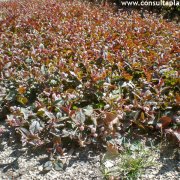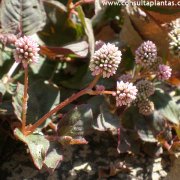Care of the plant Persicaria capitata or Pink knotweed |
|
The genus Persicaria, family Polygonaceae, comprises 100 species of herbaceous, perennial, and annual plants native to all continents. Some species are: Persicaria capitata, Persicaria affinis, Persicaria odorata, Persicaria bistorta, Persicaria maculosa, Persicaria lapathifolia, Persicaria amphibia. Common names: Pink knotweed, Pink bobbles, Pink-head knotweed, Japanese knotweed. This species is native to the Himalayas. Scientific synonyms: Polygonum capitatum, Cephalophilon capitatum. They are prostrate plants that reach 10 cm (3-93") in height. They are interesting for the green and bronze leaves (sometimes with a dark V in the upper part) and for their tiny and abundant pink flowers that appear in spherical heads. They bloom from late winter to early fall. Pink knotweed is used to form flowerbeds and borders combined with Tradescantia, Bacopa, Brachyscome, Saxifraga and Ajuga. It's ideal for patios, terraces and balconies in hanging pots. Persicaria capitata grows in direct sun, semi-shade and shade exposures. It resists frosts down to -9 ºC (15.8 ºF) but lose its leaves. Japanese knotweed prefers a loamy soil but can grow in any garden soil. Water regularly so that the substrate is always slightly damp (never waterlogged); Pink knotweed resists a few days of drought. Fertilize with compost or manure in late winter. Japanese knotweed does not need pruning but their expansion must be monitored so that they do not become invasive plants. Persicaria capitata is an easy to grow plants it's resistant to the usual diseases and pests. Pink knotweed is propagated by division in early fall or spring. |
Images of the plant Persicaria capitata or Pink knotweed |
Find plants
Persicaria capitata or Pink knotweed | Care and Growing
© 2026 FavThemes


